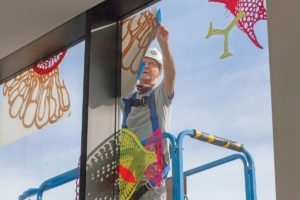
Cogswell installing his outsized images last fall. He says he “wanted to create something that would make visible some aspect of the natural world that we don’t normally pay attention to,” and suggests viewing on a sunny day, when they cast colorful shadows inside the museum.
Who else but Jim Cogswell, the Stamps School prof who previously enlivened the U-M Museum of Art and Kelsey Museum of Archeology with “Cosmogonic Tattoos,” vinyl cutouts based on objects from their collections.
For the new Natural History Museum, Cogswell says, he instead “wanted to create something that would make visible some aspect of the natural world that we don’t normally pay attention to. Microbiologists and medical researchers are aware of the world of microorganisms, but the rest of us live in ignorance of it because we can’t see it.
“It’s a fascinating world, so I thought, ‘Let’s put it out there so people can experience it, this incredible diversity of life forms.’ ”
He chose the 200 or so microorganisms not on any biological principle, but based on their aesthetic features and how they coordinated with the environment of the building and windows.
“They had to be photogenic,” Cogswell says. “I selected them because they had interesting shapes. I had to be able to describe them on a flat surface, so if they had internal activity that could create openings, holes, in the internal shape, that would make it more compelling on the glass. It’s the way that you see through the shape that makes it interesting.”
He didn’t want a static gallery. His goal was “to create movement, so when people see the side of the building, they don’t stand in one place and look at it like they would with a painting; they move around.
“So my job was to guide people by creating movement around the building. Another real important thing is shadows. I grouped organisms together so that they would cast shadows.” For maximum impact, he encourages visitors to “come when the sun is shining so they can enjoy the shadows.”
The process started with ink drawings of each organism. He translated the drawing to vector files using Adobe Illustrator then “put those files to work to create a design.”
The finished design was outputted to a digital cutter, which produced roughly 1,700 square feet of images on adhesive vinyl. (It’s the same technology stores use to put signage on their windows.) Stamps School students helped assemble individual elements into multicolored images.
“I think it helps to put our human world in perspective, to see the very small part that we play in it,” says Cogswell. “We have a powerful influence on our natural environment, but our natural environment is much, much bigger, cosmologically as well as microscopically, than what we’re aware of on a daily basis.
“And our world is influenced by these organisms because we depend on these organisms. They’re part of our bodies, they live on our skin, they create the air that we breath; in some instances, they can kill us.”
But don’t bother hunting for the spiky profile of Sars-COV-2. Work on the exhibit began before the pandemic, and Cogswell chose not to add it. By now, he figures, everybody is “hyper-aware” of that particular microorganism.

